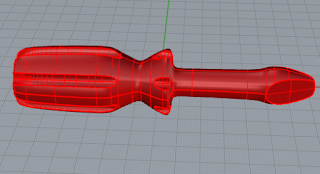Rubber Duck
Designing a Rubber Duck
Designing the Rubber Duck:
By this point in the class I was getting pretty familiar with the software. Still not feeling 100% about my skills in Rhino, but I knew that I could follow a tutorial. In this assignment I felt like I was kind of getting the hang of it. To start designing the duck, I made two spheres. One for the body, and one for the head. After that, we had to "rebuild" the duck. This was my first time using this command so I was confused on what exactly it did. Using the rebuild command helps it become "deformable" and allows more control over smaller parts of the surface. Rebuilding it also adds control points and from there, you can essentially use the "Gumball" command to move around areas of the duck. I flattened the bottom of the body to make it appear as if the duck is sitting down. After this step, we reshaped the chest and tail area. You essentially do the same steps for the head, molding it into a duck shaped head. Then, we separate the bill from the head. We did this step so we could later add color to the bill to distinguish it from the head. Then, we create the duck's neck by using the command "blend surface." After this step we had to join all of the parts together. Making an eye for the duck came next. It's crazy to me how everything you make in Rhino basically comes from a single line or point. I made the eye by using curves and the revolve command. The revolve command is a really important one, because it allows you to do less work and make a model symmetrical. At this point we are pretty much done. All that's left to do is add materials and render. Of course, I made my rubber duck yellow, adding orange to the bill and black to the pupil. I was pretty proud of this assignment because I made a really cute duck model.
What Could I Have Done Better?
I probably could have made the body more realistic looking, and made the tail look more like a duck's tail. The bill has an odd looking shape to it as well. Overall the duck looks pretty average compared to what the rest of the class did, but if I could go back right now and create a rubber ducky, you would again see significant improvement in my work. The submission photo of the duck only shows half of the duck's body, so I could definitely done better on making sure the renderings were in good frames. I probably could have made the eyes a slightly smaller shape, looking back at the picture they look really bulged out of his head. I also would have turned the assignment in on time. I struggled getting all of the assignments in on time, due to the fact that I was learning at a slower pace than the majority of the class. I also didn't turn in the Rhino file for the assignment, so I would've better listened to instructions and turned in the file attached.
What Aspects of the Project I am Happy About:
The rubber duck assignment turned out pretty well I think. Overall I did a pretty average job modeling my own version of a rubber duck. I think for the most part I followed the instructions pretty well. When we had to add materials to the duck I felt I did pretty good with that. I added yellow to the entire body, orange to the bill, and black and white for the eyes.
What Would I do Differently in the Future:
Moving forward, I would know how to make better use of control points, know how to proportion things like the bill better, and know how to render/use the angles of the pictures better. If I could go back, I would know how to better make use of the instructions and commands. I would definitely take more photos for the renderings.
What Did I Learn from this Project?
In this project, I learned how to rebuild objects and use control points. With these two commands you can reshape things and mold things to whatever shape you want them to be in, like a rubber duck. I learned how to make use of materials and colors. In this project I learned somewhat how to work with layers. This was a concept that was pretty difficult for me to grasp, but more and more I was learning how to work with all of the different commands and techniques.




Comments
Post a Comment